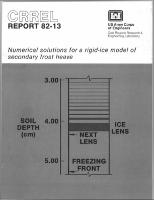Please use this identifier to cite or link to this item:
https://hdl.handle.net/11681/9344| Title: | Numerical solutions for a rigid-ice model of secondary frost heave |
| Authors: | United States. Federal Aviation Administration United States. Federal Highway Administration New York State College of Agriculture. Department of Agronomy O'Neill, Kevin, 1946- Miller, Robert D. (Robert David), 1922- |
| Keywords: | Finite element method Regelation Freezing Soil Ice Frost heave Frost heaving Numerical model |
| Publisher: | Cold Regions Research and Engineering Laboratory (U.S.) Engineer Research and Development Center (U.S.) |
| Series/Report no.: | CRREL report ; 82-13. |
| Description: | CRREL Report Abstract: In this paper, frost heave is analyzed for the common case in which some ice penetrates the soil. In this situation, heave is due to the accumulation of soil-free ice just within the frozen zone, behind a frozen fringe of finite thickness. Heat and mass transport within and across that fringe are crucial processes in the dynamics of heave. This analysis concentrates on activity within the fringe, also connecting that activity to heat and mass flows in the more frozen and unfrozen zones. Each component in a set of governing differential equations is developed from rational physics and thermodynamics, using previous experimental work. It is assumed that the soil ice grows through interconnected interstices; hence it constitutes and can move as a rigid body. When this assumption is translated into mathematical terms, it completes the governing equations. The model resulting from these considerations is a one-dimensional finite element computer program that solves the equations for arbitrary initial and boundary conditions. The model is used to simulate the heave history of a hypothetical soil column frozen unidirectionally and sUbjected to a surcharge. The results are gratifying in that they predict qualitatively the characteristics of numerous laboratory observations. Some questions about the completeness of the theory remain, and strict verification of the model awaits further experimentation and better parameter identification. |
| Rights: | Approved for public release; distribution is unlimited. |
| URI: | http://hdl.handle.net/11681/9344 |
| Appears in Collections: | CRREL Report |
Files in This Item:
| File | Description | Size | Format | |
|---|---|---|---|---|
| CR-82-13.pdf | 662.06 kB | Adobe PDF |  View/Open |